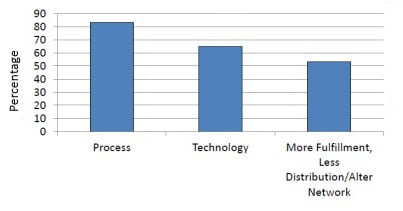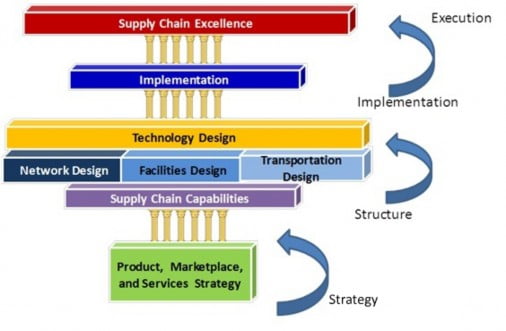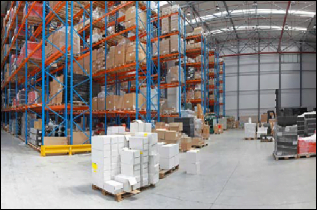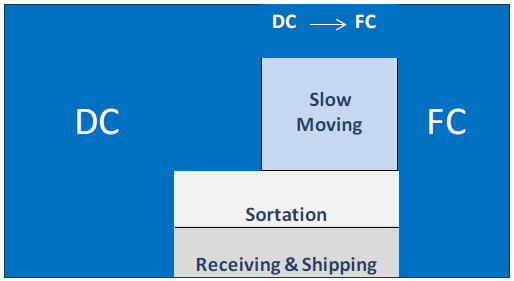What Today’s 3PLs Need to Know
Jim Tompkins
CEO, Tompkins International
Valerie Bonebrake
Senior Vice President, Tompkins International
Introduction
In the last 20 years, e-commerce has exploded from a platform for buying books online to a massive business where consumers can buy virtually anything online. As new services and avenues to shop are introduced to the market, many agree and expect that merchants must be great in all channels in order to provide competitive prices, an awesome selection, best- in-class convenience, and a personalized experience-regardless of how, where, or when customers shop.
Alibaba is poised to provide an even greater disruption to an already dynamic marketplace.
This massive market disruption, now known as omnichannel, is here to stay. We believe that the disruptions of the last 20 years will pale in comparison to the pace and breadth of change we will see in the next two to three years. This paper will accelerate your thinking about how third-party logistics (3PL) solutions are changing-and will continue to change at an even faster pace-as retailers and consumer product manufacturers figure out the opportunities and challenges of today’s omnichannel strategy. While this paper focuses on consumer markets, B2B will also be impacted.
A new player has burst on the global scene, making a grand entrance via the New York Stock Exchange. This new player is Alibaba, and it is poised to provide an even greater disruption to an already dynamic marketplace.
So who is Alibaba and why does it matter? Alibaba owns Taobao, China’s largest shopping website. It also owns Tmall, which offers a wide selection of branded goods to China’s emerging middle class. In addition, Alibaba runs an online payment system that operates similar to PayPal.
Alibaba’s IPO launched in New York City on September 19, 2014 (it was the largest IPO ever). Although Alibaba is not yet well-known in the U.S., consider that:
-
231 million people in China used Alibaba in 2013.
-
Alibaba offers 1 billion unique items from approximately 10 million merchants.
-
Alibaba shipped 5 billion units in 2013.
-
Alibaba will participate in more than $450 billion in retail sales in 2014 and will generate a profit of more than $7 billion.
The Changing Landscape
The impact that Alibaba will have on the U.S. going forward is huge. E-commerce sales in the U.S. from 2013 were $264 billion. In 2014, second quarter e-commerce sales were estimated at 5.9% of all retail sales. That number will balloon during Holiday 2014 and we expect it to continue to grow.
The Alibaba IPO shines a spotlight on the impact of alternate channel options that retailers and consumer product companies have. They can access these channels through marketplace offerings that are increasingly convenient for consumers, thanks to the use of smart phones. Options abound as strategies such as “endless aisle” offerings enable retailers and marketplaces to offer thousands of products that are not stocked or sold in a store, but rather delivered to a consumer’s home or designated delivery point from the manufacturer in a direct delivery model.
Marketplaces like Alibaba present exciting new opportunities for retailers and consumer product companies. Big marketplaces get even bigger because consumers and merchants use them, which results in more advertising and traffic. Here are two ways of thinking about these marketplaces:
-
Forward marketplaces: Where retailers and consumer product companies place their unique offerings on other marketplaces such as:
-
Custom designed products
-
Private label for generic products, proprietary brands, and their “own” exclusive brands
-
-
Backward marketplaces: Where retailers place other merchants’ unique offerings on their own sites in order to:
-
Increase selection
-
Own a category or multiple categories
-
Drive online and in-store traffic
-
In today’s rapidly changing retail economy, the channels and marketplaces that retailers and consumer product manufacturers serve are expanding and becoming more complex. To be successful, sellers must have high-performing, segmented supply chains. These companies are increasingly turning to 3PLs to provide solutions that enable supply chain flexibility and agility. It is clear that e-commerce will continue to grow; consumer product companies will require fulfillment capabilities in support of their retail customers and for their consumer-direct business.
Retail distribution and fulfillment will also require new and flexible solutions. In addition to changing requirements inside the four walls, the requirement for local delivery and final mile will continue to emerge and evolve and be a significant differentiator in both service and cost.
Delivering the Goods
Recent research conducted by Tompkins Supply Chain Consortium reveals that a full 65% of all retailers and consumer product manufacturers use alternative channels, and 12% more are considering them. When it comes to managing traditional supply chain requirements, 72% of all retailers and consumer product manufacturers indicate their supply chain works well for their own company channels, but only 40% said their supply chain works well for alternative channels. Respondents indicated that changes were needed in process (82%) and technology (65%). More than half expect to increase fulfillment capabilities, reduce distribution, and alter the overall network footprint in order to meet all the requirements of traditional and alternative channels.
A number of companies are still undecided about the e-commerce strategy they will embrace. According to research by the Consortium, 14% of all retailers did not have or had not yet planned a website. Another 40% of consumer product manufacturers did not have or had not yet planned a website. One-third of all retailers are not considering alternative channels, but only 15% of all consumer product manufacturers are not considering them.

Figure 1. Changes Required to Alternative Channel Supply Chains
The Importance of Supply Chains to E-Commerce
In order to provide logistics services to retail and consumer product manufacturers in the future, it is critical to fully understand and embrace the importance of supply chain performance as the source of competitiveness. The 3PLs that can support their clients with logistics capabilities that enable supply chain excellence will be the long-term winners in the marketplace.
But this means much more than simply receiving, processing, and shipping orders. It means developing strategic relationships and working together to define the supply chain strategy, structure, implementation, and execution to support all of a customer’s supply chains, including their own channels and forward/backward marketplaces. It is highly likely that current 3PL customers are having these conversations in their boardrooms.
After all, they are seeing an inevitable shift that means store sales may have peaked, and they need to look outside of traditional channels for growth.
Retailers and consumer product manufacturers always expect cost reduction/cost improvement from a 3PL relationship. That is not a differentiating strategy. To truly set themselves apart, today’s 3PLs must provide business process improvement, end-to-end visibility to orders, events, and inventory, as well as the ability to enable selling into new channels and markets. Consider the building blocks to achieving such a relationship from the lens of the shipper in Figure 2.

Figure 2. Supply Chain as a Competitive Weapon
Your customer develops product, marketplace, and services strategies. In order to help your customer develop the right logistics capabilities for its supply chain(s), you must understand the go-to-market strategy. Your customer needs to determine what supply chain capabilities are required to meet the marketplace strategy. Often times, 3PLs only receive the information that is shared through a Request for Proposal (RFP) process.
Innovative 3PLs are utilizing new mediums to engage in strategic discussions by having strategic advisors to:
-
Facilitate innovation sessions
-
Design new fulfillment models
-
Work strategically with the 3PL and customers to develop a strategic roadmap for the path forward
This approach is particularly helpful when logistics infrastructure requires new investments in facilities, material handling equipment, and IT systems. More “thought” and less “steel” is needed in order to design the type of combined distribution center (DC)/fulfillment center (FC) that will be needed to meet new multichannel requirements. Investing upfront in this type of innovative thinking and planning-combined with the joint development of strategic roadmaps-will enable smart investments and satisfying long-term, profitable client relationships.
More on the Alibaba Effect
Alibaba, a China-based e-marketplace, has a model that creates the mechanism for commerce enabled by technology. When it comes to fulfillment, Alibaba treats logistics in various countries differently. In the U.S., where a high level of logistics capabilities has already been achieved, the view is that Alibaba will rely on merchants to provide fulfillment as opposed to building or buying its own logistics infrastructure. This model is not new as companies offer direct ship (from the manufacturer or distributor) today.
More retailers need 3PL services, and they will need new options for fast and efficient fulfillment and delivery.
What is different-and will continue to be different-is the consumer expectation for not only great prices, but also for convenience, personalized service, and fast (plus increasingly free) shipping. The bar is set high for companies to compete, and most realize that they must have an omnichannel strategy.
Some are several years into this journey, while others have not yet begun. Alibaba gives merchants the opportunity to reach thousands of new customers. Both online and mobile e-commerce continues to grow, and Alibaba will accelerate this growth. More retailers will need 3PL services, and they will need new options for fast and efficient fulfillment and delivery, which creates a tremendous opportunity for 3PLs who have their sights on the future.
Plus, for those 3PLs currently serving consumer product companies, the pallet in-full carton-pallet out model must now evolve as consumer product companies are also being asked by their customers to fulfill e-commerce orders directly for consumers. For many consumer product companies, this is completely new. To add to the complexity, each retailer they serve has its own set of requirements. Additionally, many companies are choosing to face conflict head-on because they see a need to develop their own channels for selling to the consumer directly through various marketplace options.
Omnichannel Logistics
Omnichannel demands that companies develop new strategies for filling orders. Consider the brick-and-mortar store that will source and deliver (for free) the right size and color of a dress, shoe, or shirt when the consumer does not find exactly what they want at the store. Companies like Deliv are striking deals with shopping mall operators to offer same-day delivery for store orders in the area. A consumer can place an order during the day and have it arrive at home that same evening.
Companies are figuring out the business process and enabling technologies to support all types of transactions. In response to these changes, DCs and FCs must be strategically placed to maximize sales to new and repeat customers vs. the traditional approach of minimizing cost. The design of a company’s DC/FC network must support the company’s omnichannel strategy.

Single channel vs. omnichannel to maximize revenue per customer
Figure 3. Single Channel vs. Omnichannel
There has been an evolution in customer retail connectivity. As Figure 3 shows, a single vs. omnichannel approach highlights the potential to maximize revenue per customer with a multitude of channels.
Consider this scenario:
-
Single channel (e.g., customer shops at retail store): Assume a baseline of sales of $100/customer
-
Multichannel (e.g., customer shops at retail store, in catalog, and online): Sales of $120/customer
-
Cross-channel (e.g., customer shops across retail store, catalog, and online): Sales of $160/customer
-
Omnichannel (e.g., customer has opportunity to shop within and compare between retail store, catalog, and online): Sales of $240/customer
-
Personalized Omnichannel: Sales of $400/customer
Omnichannel will play a major role going forward, not only for marketing and selling, but also for fulfillment as consumers can buy anywhere, receive delivery when and where they want it, and return anywhere.
Combining a DC and an FC

Should a DC/FC be separate or combined? Should there be one facility or multiple facilities? These are questions to consider. In general, far too many supply chains have been designed with the DC/FC separated; this is a result of the DC being primary and FC as a small piece of the total business. But given where we are and where we are going, most DCs/FCs should now be combined.
Combining the DC/FC offers several advantages:
-
Inventory optimization
-
Fewer challenges in inventory allocation by channel
-
Growing number of channels and evolution of channel volumes
-
Enhanced justification of automation
-
Different channels peaking at different times allows for the reduction of the impacts of overall peak volumes, which can smooth out staffing and facilitate cross-training of full-time warehouse employees
-
Shifting order from/ship to (order online/ship to store, order in-store/ship to home, etc.) is easier to execute

Figure 4. Combination DC/FC
Consider a traditional DC with its setup for bulk and rack storage. It has a layout setup for efficient receiving and storage, and outbound orders in case or pallet quantity. In Figure 4 above, a combination DC/FC will look much different in terms of layout, technology setup, and material handling equipment. Companies will leverage shared inventories in a multichannel fulfillment environment providing brick-and-mortar store fulfillment and e-commerce orders out of the same facility.
It’s Time to ‘Get Local’
The ‘Get Local’ methodology relies on three key items: instant gratification (click-to- doorbell), speed of delivery (high delivery expectations), and personalization, service, and loyalty. There are several factors to consider with this, including the customer’s location, age, type of product, price point, and time of year.
For 2014, “fast” delivery is considered next-day to two-day. In 2015, fast delivery will be considered same-day or next-day. When sellers ‘get local,’ inventory will need to be divided between the DC and the FC.
DC Inventory
-
Level 1: National Distribution Center (DC1): Where all inventory will be stored and distributed to nearby stores, nearby local distribution centers, and regional distribution centers. Also potentially distributed to fulfillment centers.
-
Level 2: Regional Distribution Center (DC2): Where some inventory will be stored (A and B items) and distributed to nearby local stores and local distribution centers. Also potentially distributed to fulfillment centers.
-
Level 3: Local Distribution Center (DC3): Where some limited inventory (A items) will be stored and distributed to nearby stores.
FC Inventory
-
Level 1: National Fulfillment Center (FC1): Where all inventory will be stored and fulfilled to nearby customers, nearby lights-out stores, nearby stores (click- and-collect), and regional fulfillment centers.
-
Level 2: Regional Fulfillment Center (FC2): Where some inventory will be stored (A and B items) and fulfilled to nearby customers, nearby lights-out stores, nearby stores (click-and-collect), and local fulfillment centers.
-
Level 3: Local Fulfillment Center (FC3): Where some limited inventory (A items) will be stored and fulfilled to nearby customers, nearby lights-out stores, and nearby stores (click-and-collect).
-
Level 4: Lights-Out Store (FC4): Where customers can collect their online orders (click-and-collect) and for fulfillment to nearby customers.
-
Level 5: Store (FC5): Where customers can collect their online orders (click- and-collect) and for fulfillment to nearby customers.
The design and execution of the logistics network must support the business strategy. Companies need to make decisions about the number and type of DCs and FCs. Just as retailers and consumer product manufacturers are actively looking at their networks, so too must 3PLs. Whether dedicated facilities or shared facilities, the requirements for multichannel fulfillment (even in the same facility) are a game-changer.
But that’s not all. The days are gone when a national parcel service was adequate for delivery and consumers were satisfied to receive their goods in five to seven business days. The next-day/same-day schema has given birth to a host of new delivery options, from ShopRunner to Uber, to regional and local carriers, and many more alternatives for final delivery. These new models, enabled by technology, are being tested and rolled out in highly populated areas. Final mile delivery solutions for less populated areas will need to consider shared facilities and delivery agents, all orchestrated by a strong 3PL with the capabilities to provide end-to-end visibility of inventory, orders, and information.
Conclusion
The Alibaba IPO has come and it is a big deal. It is important that companies learn more about Alibaba and alternative channels. Supply chains need to improve and 3PLs have a window of opportunity to progress and develop new capabilities and services through processes, people, and technology in order to protect existing business and to grow new business. The 3PLs who demonstrate their understanding of developing supply chain capabilities as a strategic weapon will be able to create greater value for themselves and their customers.
If retail and consumer products are verticals that your company serves or intends to serve, it is critical to provide new fulfillment services and work with regional and local parcel delivery firms. These elements will put you at the forefront of helping your customers in this new age of commerce.
Watch The Alibaba Effect video to learn how Alibaba will change U.S. logistics and take the e-commerce world by storm.
About Tompkins International
Tompkins International is a professional services firm that provides new solutions for supply chain improvement. Tompkins enables client organizations to be more profitable and valuable, while also becoming more skilled, agile, and adaptive to leading practices. We collaborate with client teams to develop improved operations strategies, supply chain planning, and execution of all the Mega Processes of supply chains (PLAN – BUY – MAKE – MOVE – DISTRIBUTE – SELL). With headquarters in Raleigh, NC, Tompkins also has offices throughout North America and in Europe and Asia. For more information, visit www.tompkinsinc.com or contact info@tompkinsinc.com.


